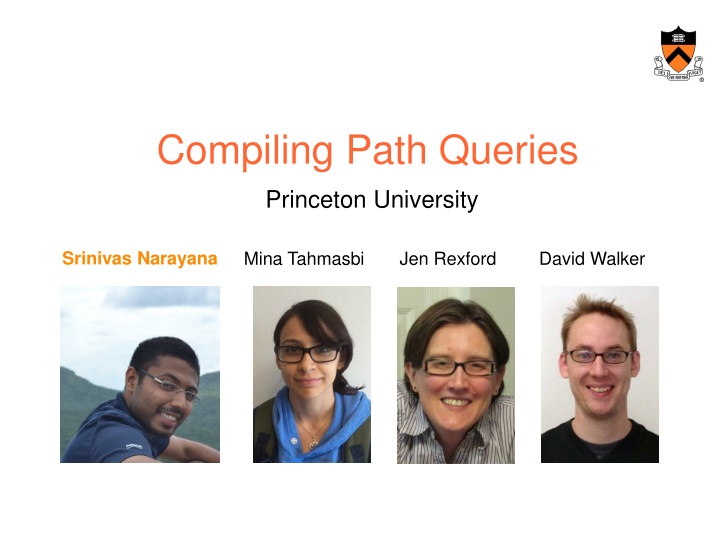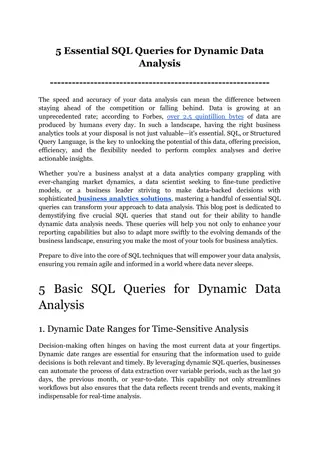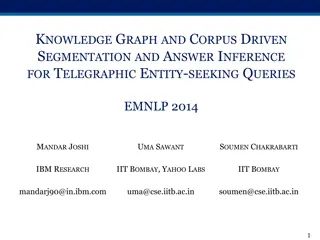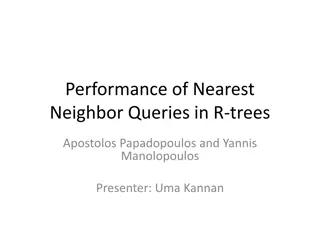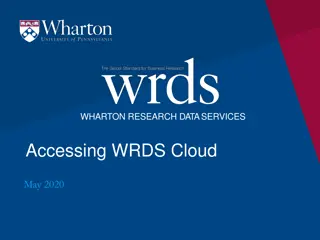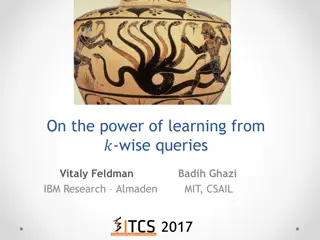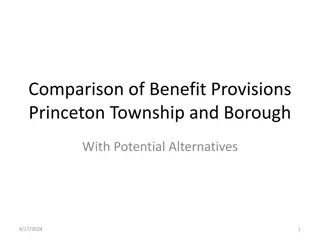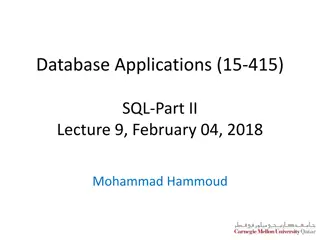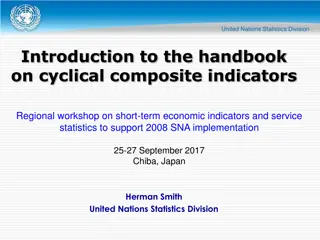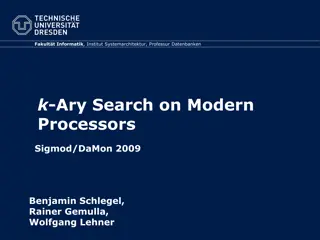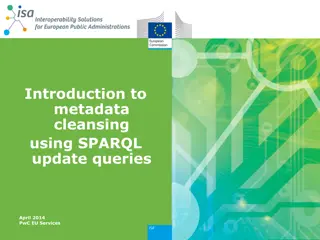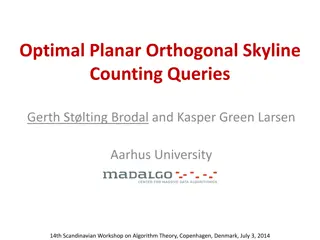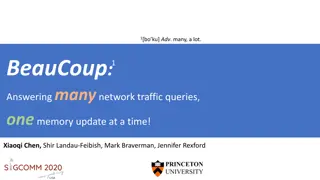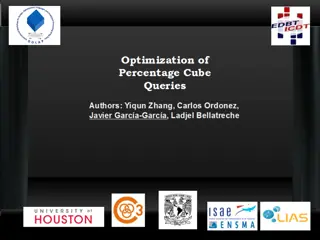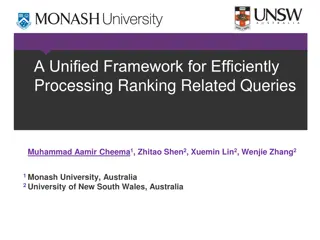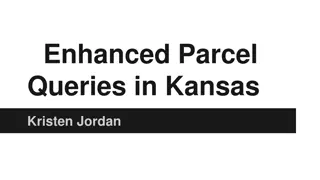Compiling Path Queries at Princeton University
Management of network controllers in Software-Defined Networking, enabling easier measurement in complex networks, and examples of troubleshooting packet loss using programmatic tools. Explore patterns combining traffic and forwarding for resource management and problem diagnosis.
Download Presentation

Please find below an Image/Link to download the presentation.
The content on the website is provided AS IS for your information and personal use only. It may not be sold, licensed, or shared on other websites without obtaining consent from the author.If you encounter any issues during the download, it is possible that the publisher has removed the file from their server.
You are allowed to download the files provided on this website for personal or commercial use, subject to the condition that they are used lawfully. All files are the property of their respective owners.
The content on the website is provided AS IS for your information and personal use only. It may not be sold, licensed, or shared on other websites without obtaining consent from the author.
E N D
Presentation Transcript
Compiling Path Queries Princeton University Srinivas Narayana Mina Tahmasbi Jen Rexford David Walker
Management = Measure + Control Network Controller Measure Control Software-Defined Networking (SDN) 2
Enabling Easier Measurement Matters Networks are asked to do a lot! Partition-aggregate applications Growth in traffic demands Stringent performance requirements Avoid expensive outages Difficult to know where things go wrong! Humans are slow in troubleshooting Human time is expensive Can we build programmatic tools to help? 3
Example: Wheres the Packet Loss? Suspect: Faulty network device(s) along the way. A B 1000 pkts 850 pkts 4
Example: Wheres the Packet Loss? Idea: Follow the path of packets through the network. Packet rewrite ip.src==a & ip.dst==b ip.src==a & ip.dst==b A B 1000 pkts 850 pkts Switch ACL counters ip.src==a & ip.dst==b count ip.dst==b fwd port 2 NetFlow Sampling Inaccuracy 5
Example: Wheres the Packet Loss? Complex & Inaccurate Join with multiple datasets: traffic, forwarding, topology High Overhead of collecting (unnecessary) data to answer a given question 6
Example: Wheres the Packet Loss? Complex & Inaccurate Join with multiple datasets: traffic, forwarding, topology High Overhead of collecting (unnecessary) data to answer a given question 7
Pattern: Combining Traffic & Forwarding Traffic matrix Uneven load balancing DDoS source identification Port-level traffic matrix Congested link diagnosis Slice isolation Loop detection Middlebox traversal order Incorrect NAT rewrite Firewall evasion ... Resource management Policy enforcement Problem diagnosis 8
Our Approach Path Query System Declarative Query Specification Independent of Forwarding Independent of Other Measurements Independent of Hardware Details Query-Driven Measurement Accurate Answers Pay Exactly For What You Query Commodity ( Match-Action ) Hardware Path Query Language Query Run-Time System 9
Our Approach 1. Path Query Language Query Expressions Forwarding Statistics 2. Query Run-Time System SDN controller Payloads 10 Statistics
How to design general measurement primitives that are efficiently implemented in the network? 11
Measurement Use Cases Traffic matrix Uneven load balancing DDoS source identification Port-level traffic matrix Congested link diagnosis Slice isolation Loop detection Middlebox traversal order Incorrect NAT rewrite Firewall evasion ... What are the common patterns? 12
(I) Path Query Language Test predicates on packets at single locations: srcip=10.0.0.1 port=3 & dstip=10.0.1.10 Combine tests with regular expression operators! sw=1 ^ sw=4 srcip=A ^ true* ^ sw=3 ingress() ^ ~(sw=firewall)* ^ egress() ingress egress ingress egress ingress egress 13
(I) Path Query Language Aggregate results with SQL-like grouping operators in_group(ingress(), [sw]) ^ true* ^ out_group(egress(), [sw]) ingress() switch #pkts (ingress(), egress()) switch pairs #pkts S1 1000 (S1, S2) 800 S2 500 (S1, S5) 200 S5 700 (S2, S5) 300 ... ... ... ... Return packets, counters, or samples (NetFlow/sFlow)
How do we implement path queries efficiently? In general, switches don t know prior or future packet paths. 16
How to observe packet paths? Analyze packet paths in the data plane itself Write path information into packets! [{sw: S1 port: 1 srcmac: ... srcip: ... ...}] [{sw: S1, ...}, {sw: S2, ...}, {sw: S3 port: 2 ...}] [{sw: S1, ...}, {sw: S2 port: 3 srcmac: ... ...}] Pros: accurate trajectory information Cons: too much per-packet information 17
Reducing Path Information on Packets Observation 1: Queries already tell us what s needed! Only record path state needed by queries Observation 2: Queries are regular expressions Regular expressions Finite automaton (DFA) Distinguish only paths corresponding to DFA states 18
Reducing Path Information on Packets Record only DFA state on packets (1-2 bytes) Use existing tag fields! (e.g., VLAN) 19
(II) Query Run-Time System (sw=1 & srcip=A) ^ (sw=4 & dstip=B) sw=1 & srcip=A sw=4 & dstip=B Q0 Q1 Q2 Switch 1: Switch 4: state=Q0 & srcip=A state=Q1 state=Q1 & dstip=B state=Q2 AND count!
(II) Query Run-Time System Each packet carries its own DFA state Query DFA transitions distributed to switches as match-action rules! Packet satisfies query iff it reaches accepting states Pay for what you query 21
(II) Run-Time: Juicy details in paper Packet forwarding shouldn't be affected by DFA rules No unnecessary duplicate traffic should be created Handle query overlap Predicates can also overlap srcip=A ^ dstip=B sw=1 ^ true* ^ sw=4 Handle groupby aggregation Capture upstream or downstream of queried path Test predicates before or after forwarding on switch Optimizations: to make the system practical 22
Evaluation Prototype on Pyretic + NetKAT + OpenVSwitch Publicly available: http://frenetic-lang.org/pyretic/ Queries: traffic matrix, DDoS detection, per-hop packet loss, firewall evasion, slice isolation, congested link Results on Stanford backbone (all queries together): Compile time: 5 seconds (from > 2 hours) # Rules: ~ 650 # State bytes: 2 bytes 23
Evaluation: Scaling Interactive problem solving (~ 15s) 24 Miller, Response time in man-computer conversational transactions
Summary We need good abstractions to measure networks Abstractions must be efficiently implementable We implemented declarative queries on packet paths: Packet state akin to a deterministic automaton Path queries can simplify network management! Queries? http://www.cs.princeton.edu/~narayana/pathqueries https://youtu.be/VxOaN9iGPWc 25
(I) Language: Related Work Primitive Description Prior Work Our Extensions Atomic Predicates Boolean tests on located packets [Foster11] [Monsanto13] Switch input and output differentiation Packet Trajectories Regular expressions on atomic predicates Group results by location or header fields Get packets before or after queried path Actions on packets satisfying queries [Tarjan79], [Handigol14] Additional regex operators (&, ~) Result Aggregation SQL groupby, [Foster11] Group anywhere along a path Capture Location -- N/A Capture Result [Monsanto13] Sampling (sFlow) 27
(I) Capture locations Capture upstream, downstream or midstream Downstream Upstream Midstream Packet flow on query path 28
(II) Run-Time: Data Plane Rule Layout In table >> Forwarding >> Out table state=Q_i & pred: state Q_j AND out_capture state=Q_i & pred: state Q_j AND in_capture forwarding 29
(II) Query Compilation ) DFA- Transitioning Forwarding DFA- Accepting >> ( + All acting on the same data plane packets! Use policy composition operators and compiler 30 Composing software-defined networks. Monsanto et al., 2013
(II) Query Compilation ) DFA- Transitioning Forwarding DFA- Accepting >> ( + dstip=10.0.0.1 fwd(1) state=Q0 & switch=S1 & srcip=10.0.0.1 state Q1 dstip=10.0.0.2 fwd(2) >> state=Q1 & switch=S2 & dstip=10.0.0.3 state Q2 dstip=10.0.0.3 fwd(3) ... state=Q0 & switch=S1 & srcip=10.0.0.1 & dstip=10.0.0.2 state Q1, fwd(2) 31 Composing software-defined networks. Monsanto et al., 2013
(II) Query Compilation (DFA-Ingress-Transitioning >> Forwarding >> DFA-Egress-Transitioning) + (DFA-Ingress-Accepting) + (DFA-Ingress-Transitioning >> Forwarding >> DFA-Egress-Accepting) 32
(II) Detecting Query Overlaps Predicate overlaps: q1: srcip=10.0.0.1; q2: dstip=10.0.0.2 Automaton can only have one state! Query overlaps: q1: sw=1 ^ sw=2 q2: srcip=10.0.0.1 ^ dstip=10.0.0.2 q1: in_atom(srcip=10.0.0.1) q2: out_atom(srcip=10.0.0.1) Automaton states must distinguish all possibilities! 33
(II) Detecting Query Overlaps Predicate overlaps: Generate orthogonal predicates! q1: srcip=10.0.0.1; q2: dstip=10.0.0.2 Generated predicates: srcip=10.0.0.1 & dstip=10.0.0.2 srcip=10.0.0.1 & ~dstip=10.0.0.2 ~srcip=10.0.0.1 & dstip=10.0.0.2 34
(II) Detecting Query Overlaps Query Overlaps: Convert in_ and out_ atoms to in_out_atoms: in_atom(srcip=10.0.0.1) in_out_atom( srcip=10.0.0.1, true) out_atom(dstip=10.0.0.1) in_out_atom(true, dstip=10.0.0.1) 35
(II) Detecting Query Overlaps Query Overlaps: Build one DFA for many expressions together in_atom(srcip=H1 & sw=1) ^ out_atom(sw=2 & dstip=H2) in_atom(sw=1) ^ in_out_atom(true, sw=2) [ceg] [adf] Q3c Q5 Q2 a Q1 e Q0 [ceg] [adf] [ce] Q7 Q8 Q4 Q6 d 36
Optimizations: Summary Optimization # Rules? Time? # States? Separate query & forwarding actions into separate stages Optimize conditional policy compilation Integrate tagging and capture policies Pre-partition predicates by flow space Cache predicate overlap decisions Decompose query predicates into multiple stages Detect predicate overlaps with Forwarding Decision Diagrams 37
Benefit of Optimizations (Stanford) Cumulative Optimization Time (s) # Rules # State Bits None > 7900 DNF DNF Separate query & forwarding actions into separate stages Optimize conditional policy compilation Integrate tagging and capture policies Pre-partition predicates by flow space Cache predicate overlap decisions Decompose query predicates into multiple stages > 4920 DNF DNF > 4080 DNF DNF 2991 2596 10 56.19 1846 10 35.13 1846 10 5.467 260 16 38
Demo: Wheres the Packet Loss? A B 1000 pkts 850 pkts 39
Demo: Wheres the Packet Loss? https://youtu.be/VxOaN9iGPWc 40
Downstream Query Compilation (3/3) ) DFA- Transitioning Forwarding DFA- Accepting >> ( + All acting on the same data plane packets! Use policy composition operators and compiler 41 Composing software-defined networks. Monsanto et al., 2013
Downstream Query Compilation (3/3) ) DFA- Transitioning Forwarding DFA- Accepting >> ( + dstip=10.0.0.1 fwd(1) state=Q0 & switch=S1 & srcip=10.0.0.1 state Q1 dstip=10.0.0.2 fwd(2) >> state=Q1 & switch=S2 & dstip=10.0.0.3 state Q2 dstip=10.0.0.3 fwd(3) ... state=Q0 & switch=S1 & srcip=10.0.0.1 & dstip=10.0.0.2 state Q1, fwd(2) 42 Composing software-defined networks. Monsanto et al., 2013
Downstream Query Compilation (3/3) (DFA-Ingress-Transitioning >> Forwarding >> DFA-Egress-Transitioning) + (DFA-Ingress-Accepting) + (DFA-Ingress-Transitioning >> Forwarding >> DFA-Egress-Accepting) 43
II. Rule Count Switch TCAM capacity: 2K-4K rules 44
III. Packet State Bits MPLS VLAN 45
